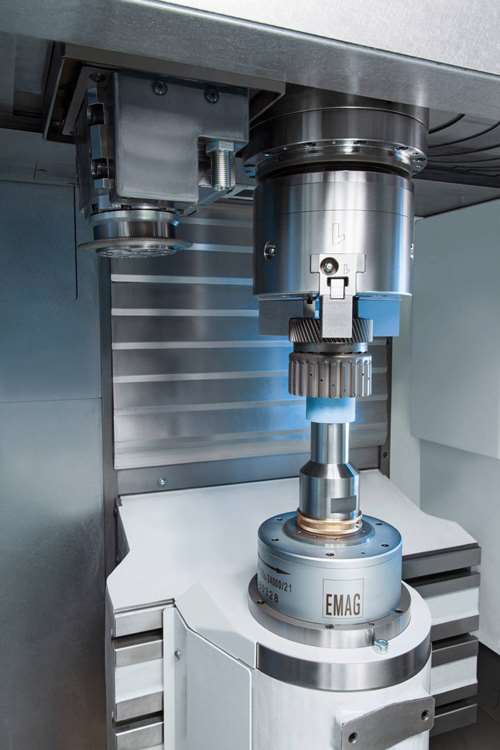Small Grinding Center Offers Big Productivity Boost
This vertical grinding center for small chucked components with a maximum diameter of 100 mm was developed specifically to meet increasingly higher output levels and shorter cycle times.
While the world economies remain quite unstable, it’s hard to deny that automobile manufacturers have experienced a strong increase in sales through the past year or so. The biggest increases were experienced in the U.S., China, India and Russia. However, the rapidly increasing number of vehicles built also brought some production challenges. The sub-contractors must deal with the increasing output levels and also need to ensure that process safety and component quality do not suffer. In fact, even the smallest components with complex geometries must be produced with increasing levels of precision.
Small chucked components are typically produced in large quantities. The demand for components, such as gearwheels, planetary gears, chain gears and flanged components for cars, have necessary quantities that typically go into the millions; and short cycle times in the production of these components have become mandatory. For instance, the internal contour of a gearwheel must be ground in the shortest possible time, and the machine’s workholding unit must be loaded with a new workpiece just as quickly. In many production environments, this reloading time represents a critical moment, because the idle time is commonly a decisive factor in establishing the economic viability of the entire process.
Featured Content
Automatic Loading Scores Heavily
The VLC 100 G vertical grinding center from Emag, for small chucked components with a maximum diameter of 100 mm, was developed specifically to meet increasingly higher output levels and shorter cycle times. The machine utilizes its onboard pick-up system to load itself, and while one workpiece is being machined, either the operator or the automation system puts the raw parts on the conveyor belt. This smooth workflow reduces idle time and increases output rates. The vertical machining design ensures that the grinding sludge falls to the bottom of the machine unhindered, where it is then transported out of the machine.
Measuring processes can also be integrated into the machine, making quality control an integral part of the process. The measuring probe is located between the machining area and pick-up station, where it is protected from contamination.
Two Grinding Wheels
An important feature of the VLC 100 G is that it allows the use of two grinding spindles, which perform different grinding operations or handle both rough- and finish-grinding work. In other words, the first wheel performs the “rough” job of removing excess material from the raw part at high feed rates (the CBN wheel is designed to absorb the necessary forces), while the second wheel (with different specifications) takes over the finishing work to produce a quality surface finish on even the most challenging geometries.
This tooling combination can help to substantially reduce the grinding time of even very complex components. “For the removal of large amounts of material, two wheels offer a shorter cycle time than one, with the first wheel designed to do the rough grinding and the second one in charge of finish-grinding work,” explains Dr. Guido Hegener, managing director of Emag Salach Maschinenfabrik GmbH in Germany.
Working Together
The combination of fast loading and efficient grinding processes makes for a compelling machine concept. It can help meet the requirements posed by the dynamic developments in automotive production. Now, with the rapid increase in required quantities, the demand is for new machine concepts that can be integrated into existing production without any problem. With the VLC 100 G, two features enable it to be integrated without any problems. “Programming the workpieces with our new Emag Navigator software is simple and intuitive, saving valuable setup time. For many production environments, this is an advantage that should not be underrated,” Dr. Hegener says. Furthermore, the small footprint for the VLC 100 G helps in production planning. The stand-alone machine occupies about 4.5 square meters (48 square feet), helping to ensure that the growth of a production facility of this kind is not limited by floor space requirements.
RELATED CONTENT
-
Bond Selection for Production Grinding
Proper grinding wheel selection is essential to ensure that the required part quality, production rate, and overall cost per part is achieved. Although the type of abrasive grain is often a primary driver of wheel selection, the bonding type can also play a key role in optimizing a grinding operation.
-
10 Tips to Get the Most Out of a Grinding Machine
Following these 10 steps can help grinding shops produce high-quality tools, increase productivity, reduce breakdowns and extend machine life.
-
Grinding on a Swiss
This shop owner has developed a unique, and effective, approach to delivering a burr-free, tight-tolerance part.









